Table of content
Understanding the nuances between website and app performance marketing for e-commerce is not easy. At first sight, it seems that both require similar approaches, but it couldn’t be further from the truth.
Although there are several common points, the differences stand out from the very beginning of the sales funnel. To ensure efficiency, companies have to adjust their promotional efforts to each channel. To do that, they have to be aware of how to set up campaigns and measure results.
In this article, we delve into the details of website and app performance marketing for online stores. Its purpose is to showcase how both channels should be used for increased success rates and what are the potential obstacles to avoid at all costs.
If you want to explore this topic in the video form, watch the session below:
Understanding the Dynamics: Website vs. App E-commerce
Starting with the basics is crucial to dive deeper into the subject. A comprehensive overview of the distinctions between website and app e-commerce strategies ensures that everyone understands the intention behind certain activities and knows how to proceed.
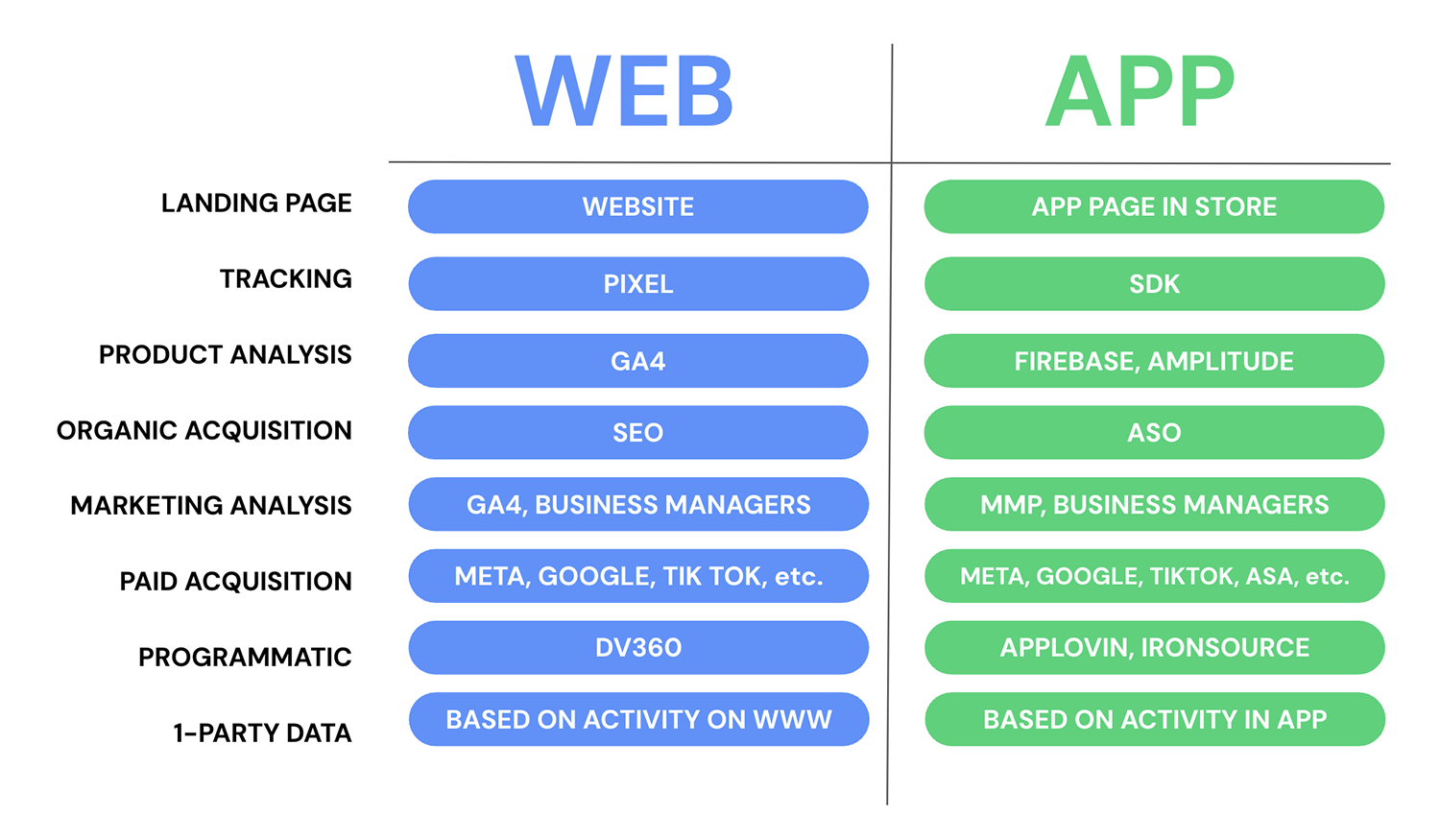
What’s likely the most crucial gap between website and app performance marketing? In the first case, we can immediately inspire the customer’s need for a certain product – for example, using website copy, interesting graphics, testimonials, and CTAs. An app requires additional steps, which are downloading and installing. Thus, the brand has to create the need to have the app first. When the user has it, they can focus on the actual shopping desire.
The Significance of Landing Pages
We’ve established the main focus points in website and app marketing. Now, it’s time for more detailed highlights on subjects like SEO and ASO, as well as discoverability metrics. Let’s begin with the pivotal role of landing pages and funnels and then proceed with various tracking mechanisms and their role in shaping the marketing approach.
Since websites are instantly available for users to enter and browse, the importance of designing proper landing pages in apps can’t be underestimated. They have to be optimized, and the best way to achieve that is by conducting A/B tests. We have to remember that the initial goal is to get customers into the app first, so it has to strictly correspond with their needs and expectations.

Moreover, apps also have their SEO counterpart – App Store Optimization (ASO). Taking care of elements like app name, rating, screenshots, previews, icons, and descriptions with proper keywords can skyrocket the results in terms of attracting new users. Other app acquisition tactics include paid ads, influencer collaborations, and digital PR.
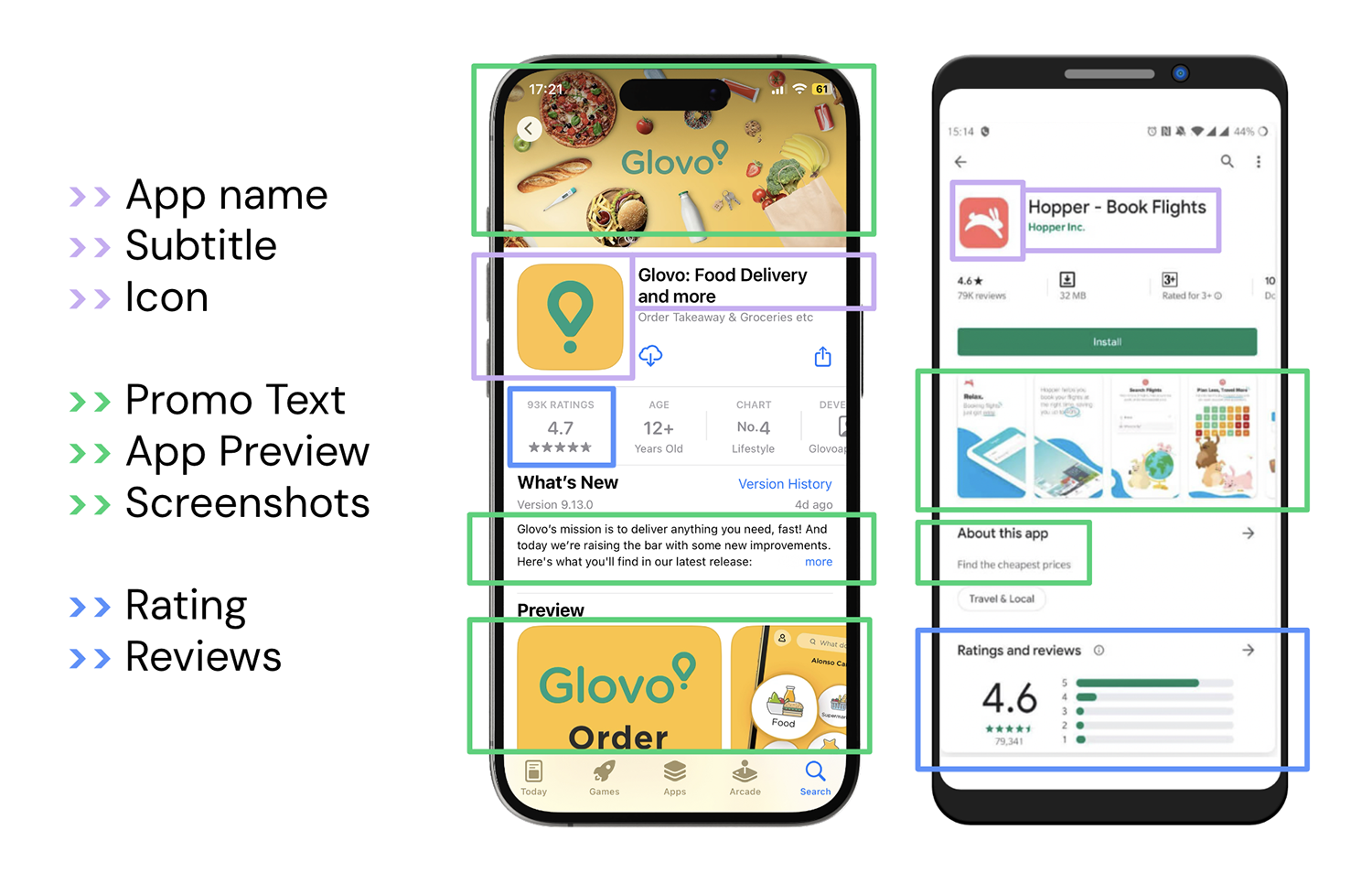
How To Measure Discoverability?
Thanks to SEO, websites rank higher in search engines, increasing the chance they will be found by curious users. ASO enables apps to be discovered in App Store and Play Store.
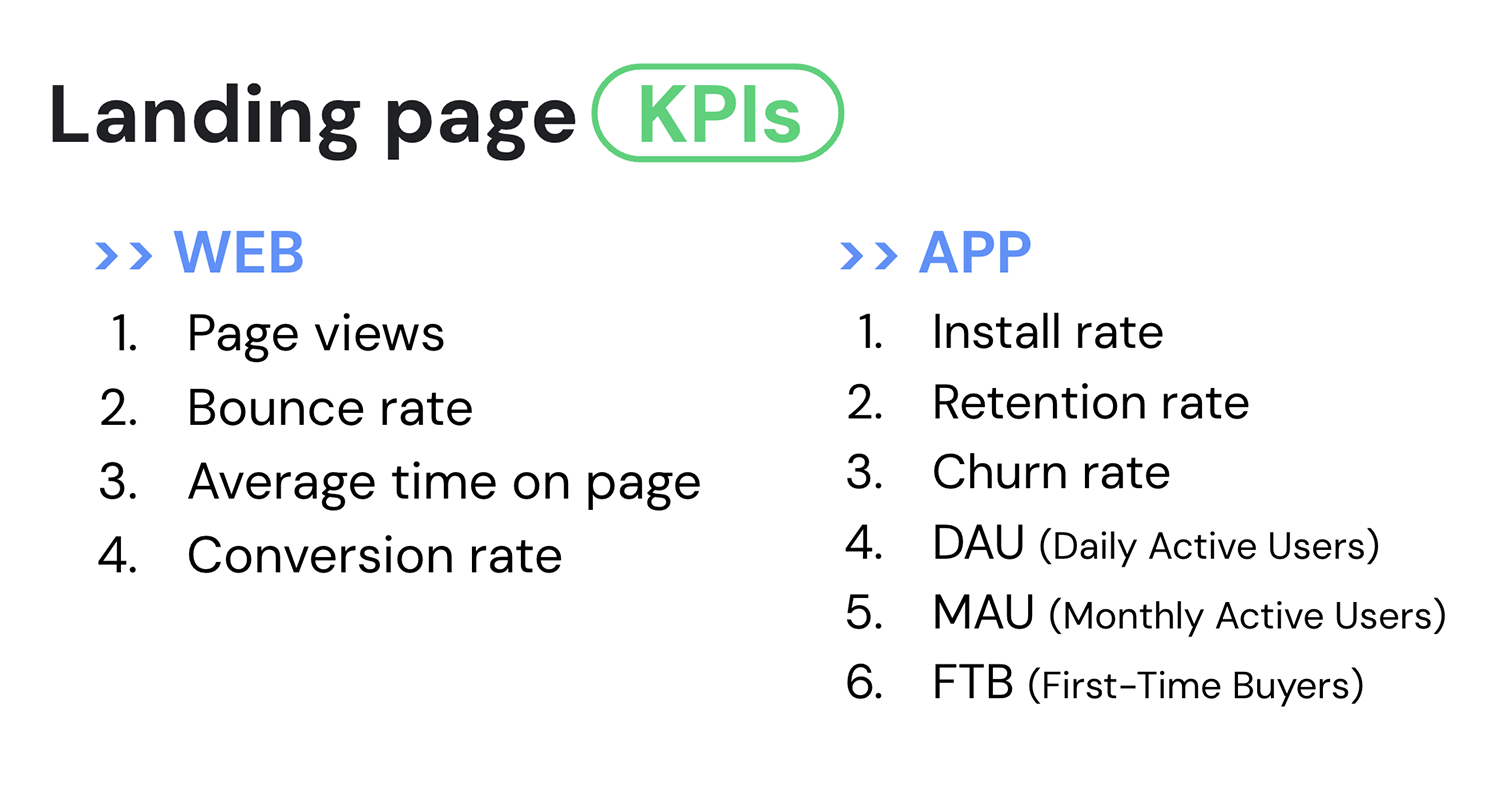
Obviously, KPIs are much different for both of these situations. Web pages are monitored for page views, bounce rates, average time spent on a particular page, and conversion rates. For apps, these metrics include install rates, retention rates, churn rates, daily active users (DAU), monthly active users (MAU), and first-time buyers (FTB).
Decoding the Funnel
Let’s not forget about the sales funnel. It’s interesting how user acquisition is completely different in website and app The unique funnel structure for applications emphasizes aggressive marketing strategies required to secure installations quickly. Retention seems to be the critical focus, especially since churn rates are quite high in the app landscape.
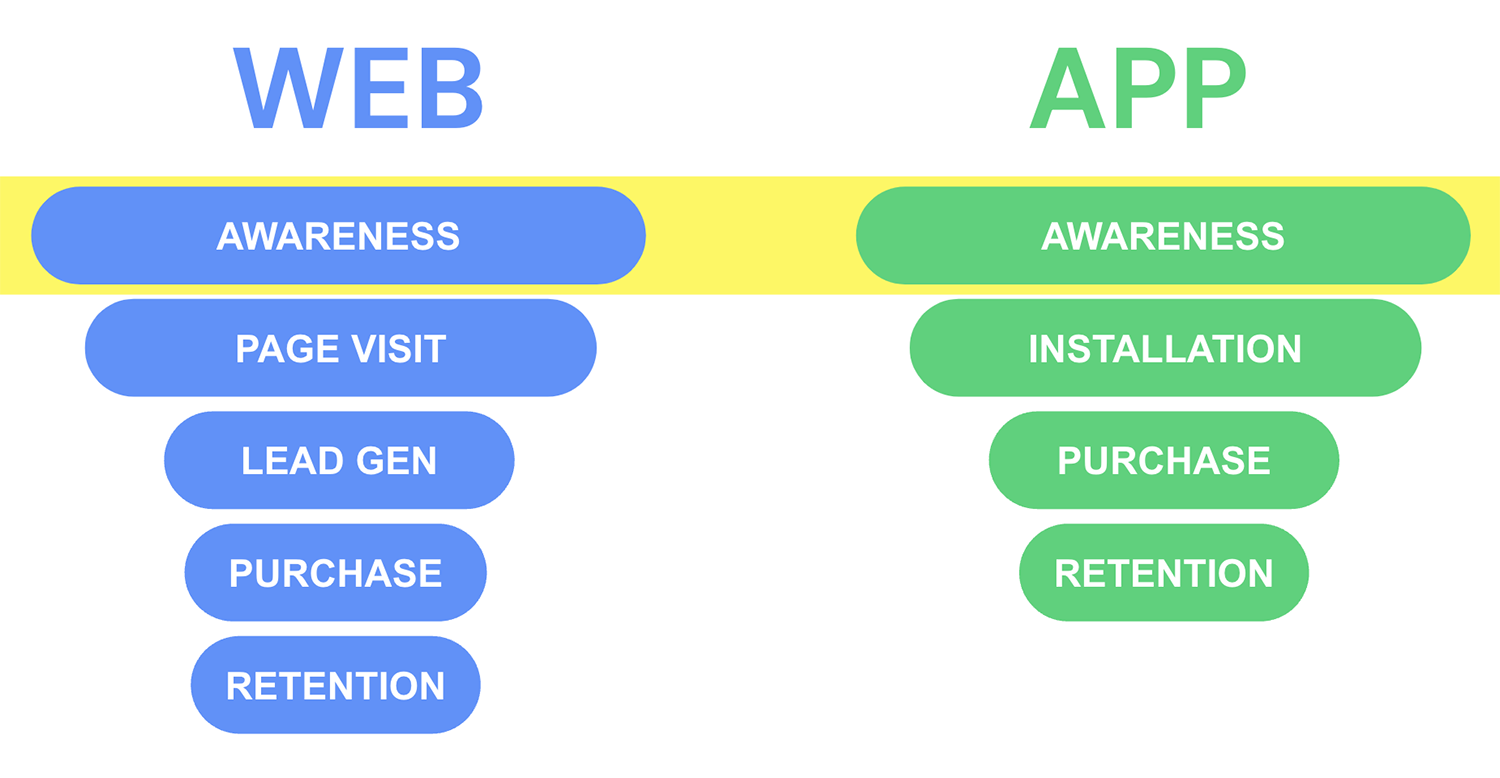
While a website funnel is longer, and the conversion happens towards the end, for apps it’s the opposite. Both funnels begin with awareness, and then it takes two directions. On pages, users spend some time ingesting information, and then they leave contact info, becoming leads. Then they are converted into buyers and retention happens.
In apps, the purchase usually happens after the installation process, and retention occurs next. Since the company puts so much effort into app marketing, users who installed the app should already know they want to buy.
Paid Media Mix for App Performance
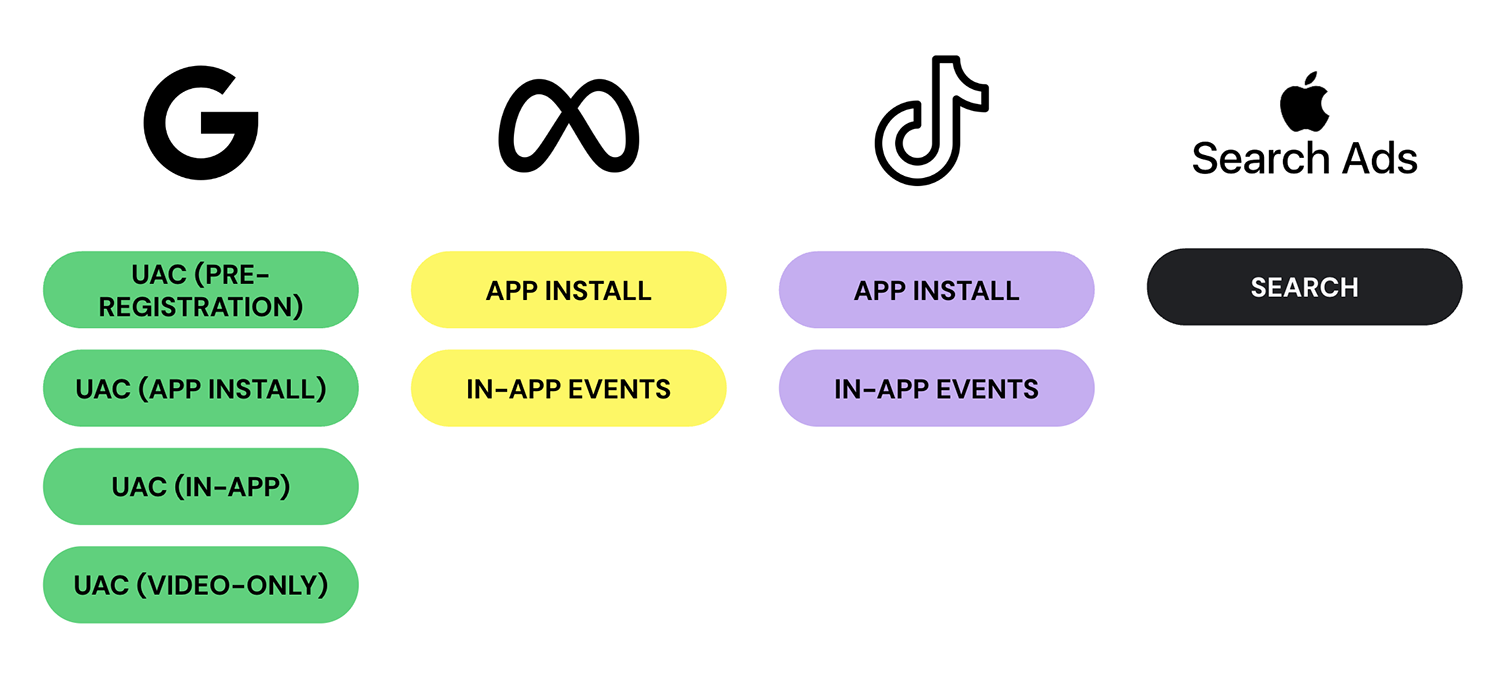
We should also navigate through various platforms, such as Google Ads, Meta, TikTok, and Apple Search Ads, to determine the nuances of each for effective app marketing. There are several ways to promote apps within these platforms, including app installation and in-app event campaigns, search ads, and pre-registration campaigns.
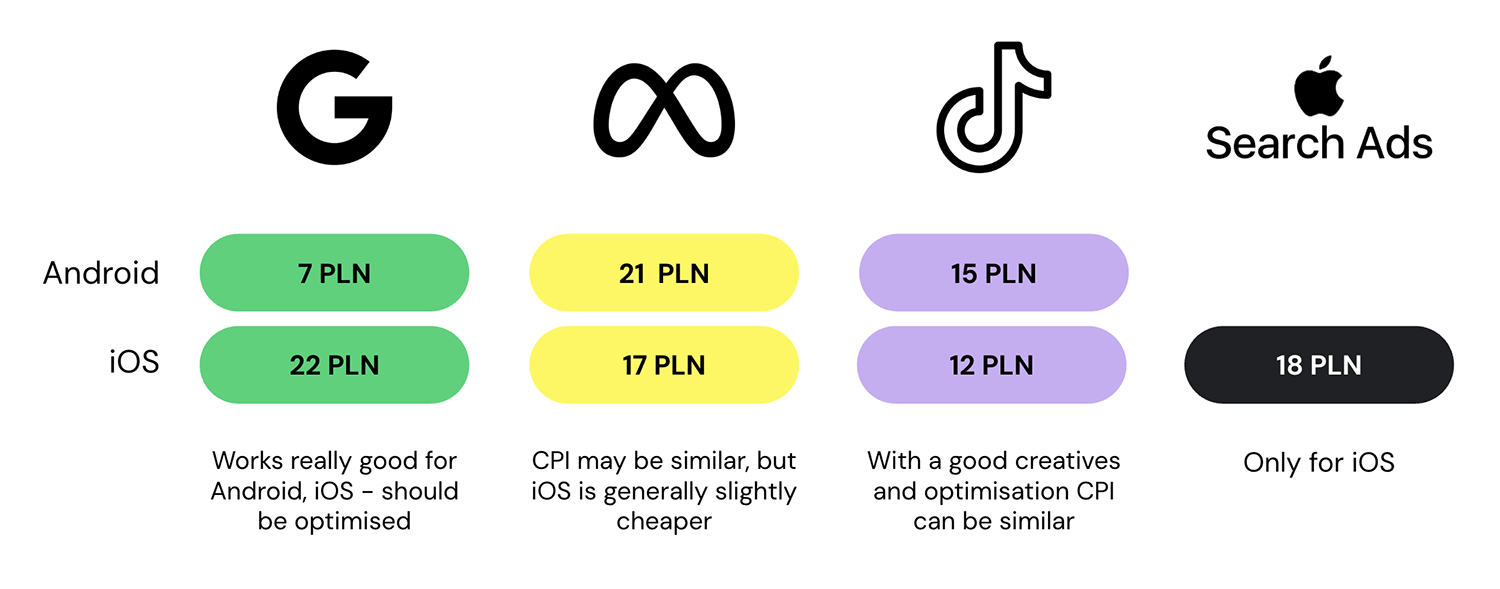
Cost-per-install (CPI) varies significantly depending on the platform, but also on the type of device we want the app installed on. For example, Google Ads works brilliantly for Android apps, but the cost of promoting iOS applications is much higher. On Meta and TikTok, it’s cheaper to market iOS apps. The results are highly dependable on good creatives, campaign execution, and optimization. It’s also important to divide campaigns between two operating systems and adjust them to their separate user groups.
Apple’s Dedicated Marketing Engine – Pros and Cons
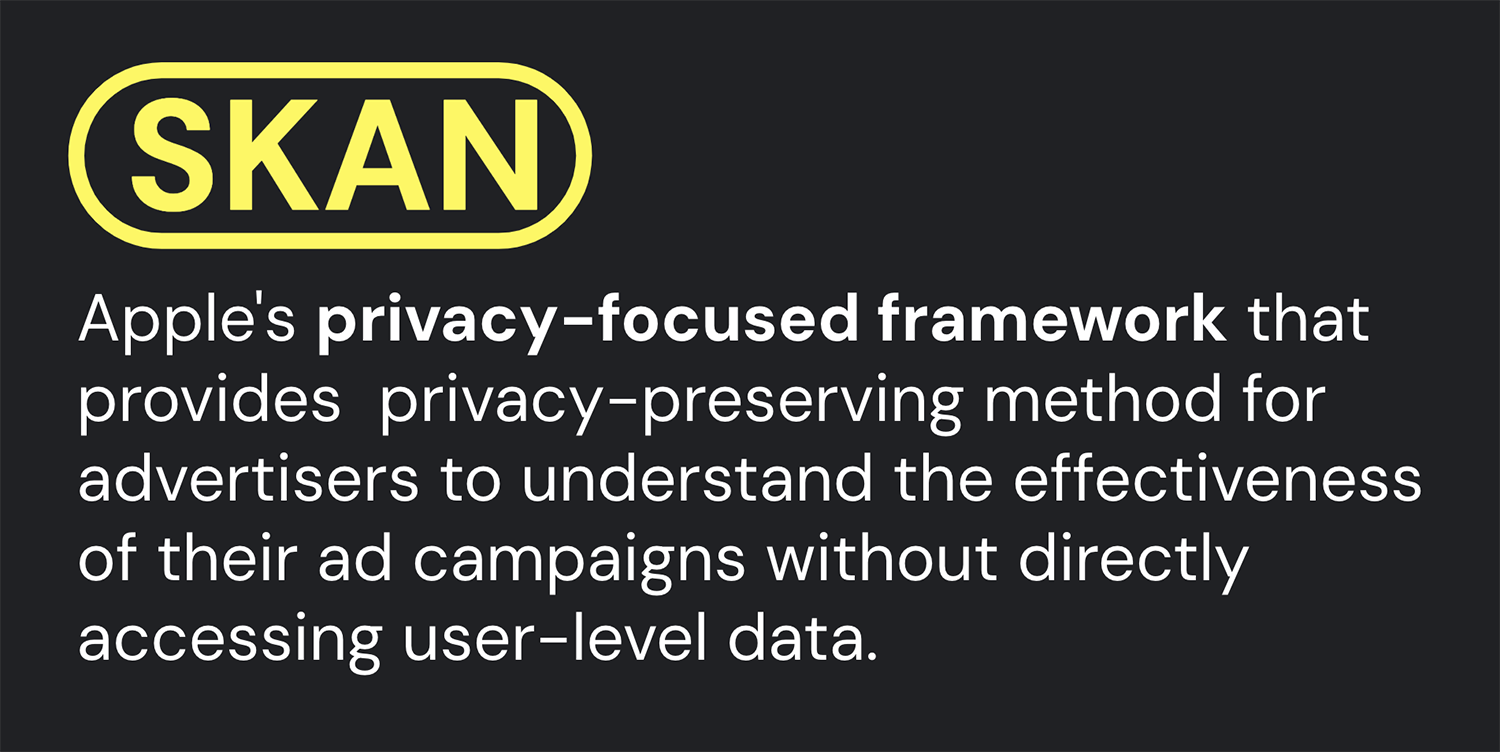
Not mentioning Apple’s unique approach wouldn’t be appropriate because it’s a game-changer for app e-commerce marketing. The SKAN framework is focused on privacy, which means iOS app advertisers can understand the effectiveness of their efforts without accessing user-level data. Taking current data security trends into consideration, Apple’s idea makes sense, but it provides certain challenges to brands that want to promote their iOS apps. The main pain points include:
- Aggregation of data, which means it’s less detailed and insightful.
- Postback delays, leading to longer attribution windows – data is displayed in 24–48 hours or even later. This makes daily optimization impossible.
- Lack of view-through attribution.
- Fraud – there’s no way to determine if the user is from a certain location or not.
Paid Media Mix – Advice for Each Platform
Here are some recommendations regarding promotional activities for apps on the most popular online platforms:
| META – Campaigns should be divided per operating system (separate for Android and iOS) – There are limitations for iOS – only 9 campaigns per account with max. 5 ad sets. – It’s crucial to target only available operating systems. – A campaign can send people to a custom product page or store listing. | GOOGLE – UAC (Universal App Campaign) is an automated campaign. Therefore, fewer elements can be changed (a video-only campaign may be implemented with a Google rep). – Retention campaigns are employed after reaching 250K installations per system, but before brands can run campaigns with in-app events bidding. – Adding all possible assets increases the excellence score (statics, videos, texts, HTML5). |
| TIKTOK – Similarly to Meta, there are limitations for iOS – only 11 active campaigns and 2 ad groups per campaign. – Launching a TikTok Smart campaign for Android is a good idea. – Excluding current users is crucial when targeting new users in the campaign. – Separate content for each placement. – Organic content is great for testing. | OTHER CHANNELS – Additional placements (e.g. Apple Search; AppNexus) should be considered. – Programmatic (DV360) is less effective, but for apps, it can be beneficial mainly as an awareness campaign. – Google Search is less valuable but should be remembered in the media mix. |
Analytics in App E-commerce
I want to take a closer look at evaluating the effectiveness of app marketing. Mobile Measurement Partners (MMP) seem to be reliable sources of truth and incredible support for marketers who want to establish what works well in their campaigns and what requires improvements.
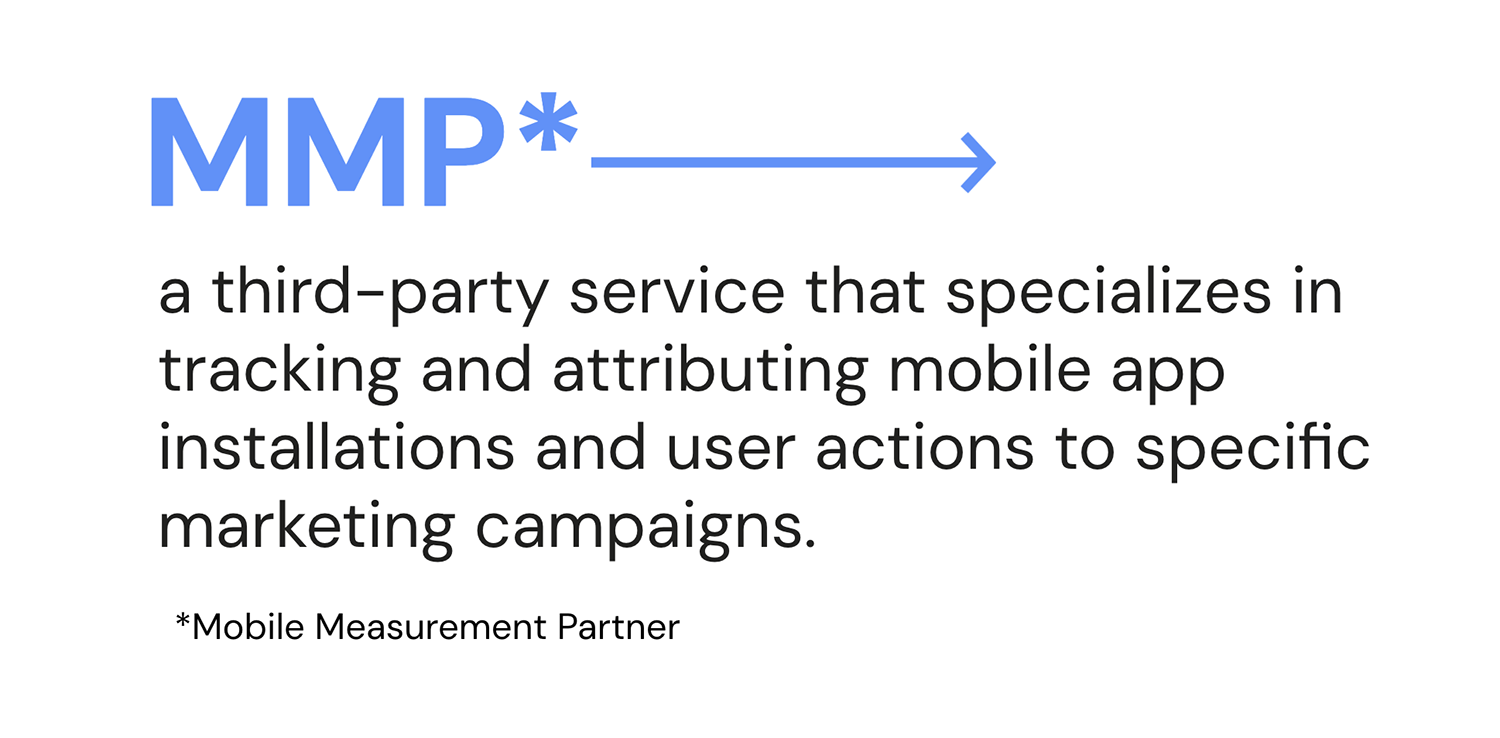
Third-party platforms can accurately track and measure app installations and user behaviors. Their main advantages include seamless integration with ads platforms, multichannel tracking, deep linking fraud prevention, advanced analytics dashboards, and reporting.

The most popular MMP tools are AppsFlyer, Adjust, and Kochava – all have demo versions and several pricing plans with various features.
Strategies for Website And App Performance Marketing
Let’s conclude with four scenarios for businesses with both web and app presence. Even though I shared a lot of the nuances of app marketing, I’m aware that most e-commerce stores promote their products in both channels. The ideas below cover a spectrum of online shops, focusing on different strategies for unique goals and resources. They provide a strategic roadmap for success:
| Scenario 1: – Main focus on website marketing for both cold and warm audiences – App marketing only for current customers | Scenario 2: – The marketing budget is evenly split – Website traffic optimized for purchasesApp traffic optimized for installations – The app promotes purchasing via the web and app |
| Scenario 3: – The marketing budget is evenly split – Website traffic optimized only for web traffic – App traffic optimized only for app traffic | Scenario 4: – The app is used as an organic traffic source – No app marketing efforts |
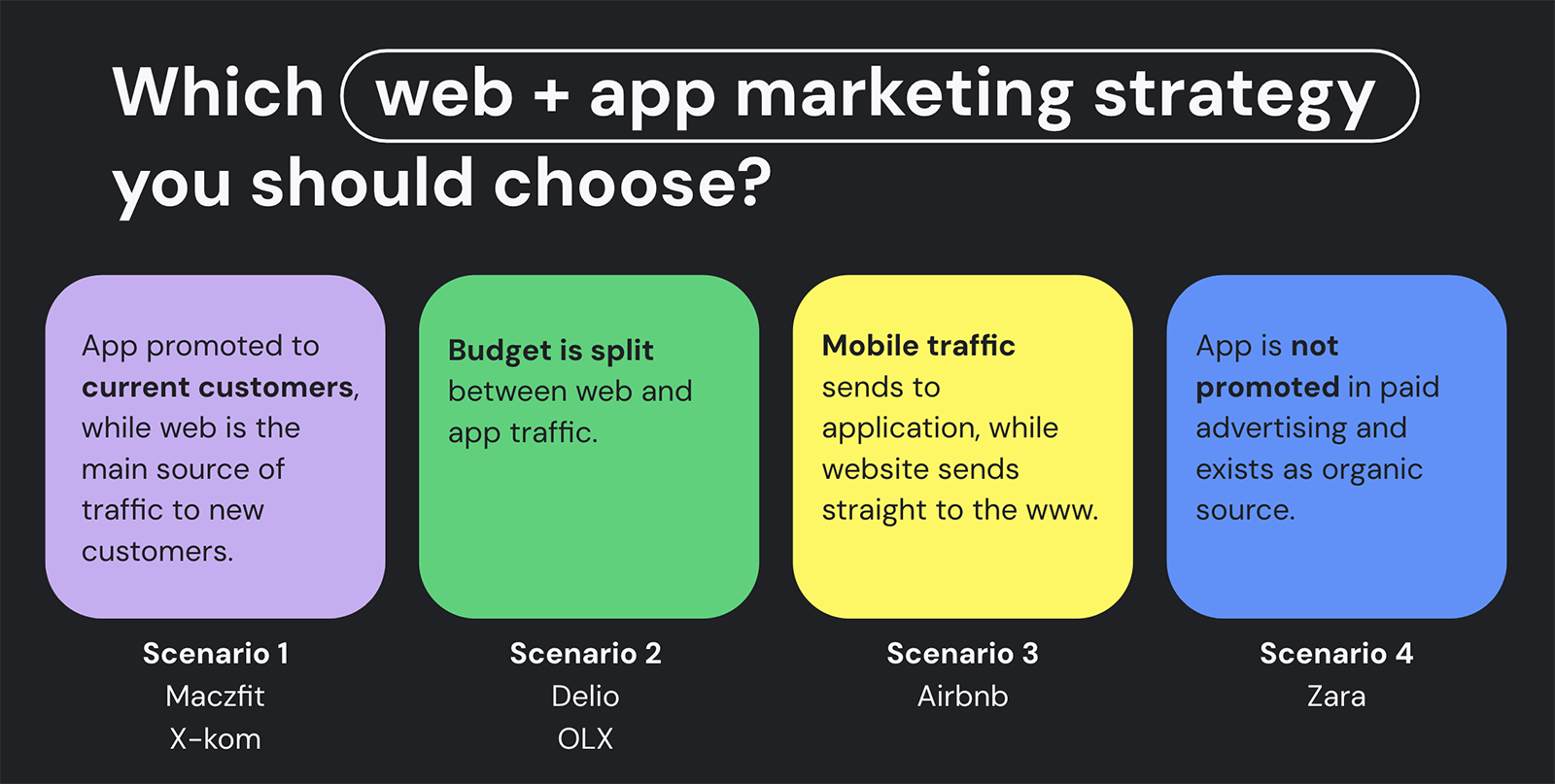
The choice between scenarios should be dictated by the business model. For example, Airbnb could take advantage of scenario 3 due to the UX design of their web and app interfaces. They can promote different channels to various customer segments, appealing to their buying preferences. On the other hand, Zara is the perfect illustration of scenario 4 – they have the app, but it’s not promoted at all.
Finding the right marketing framework for e-commerce
Knowing the secrets of website and app performance marketing means you can achieve your business objectives more efficiently, with different user needs in mind. These two channels require separate action plans.
Moreover, companies can approach them in numerous ways, focusing on one or both. I hope that sharing my knowledge backed by hands-on experience in that area will help brands decode the complexities of e-commerce marketing and empower them to achieve extraordinary results.




